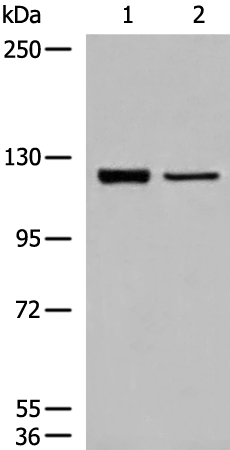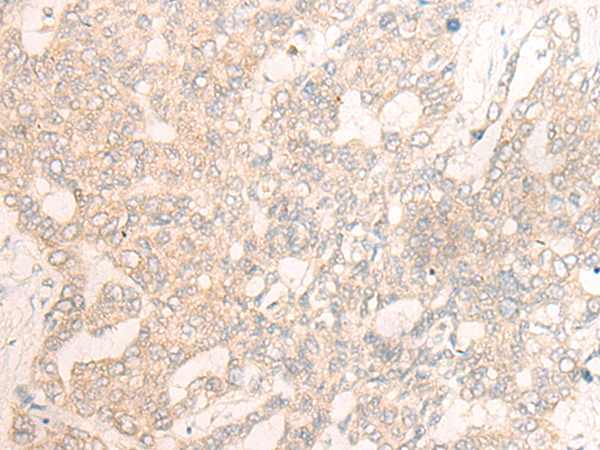


| WB | 咨询技术 | Human,Mouse,Rat |
| IF | 咨询技术 | Human,Mouse,Rat |
| IHC | 1/20-1/100 | Human,Mouse,Rat |
| ICC | 技术咨询 | Human,Mouse,Rat |
| FCM | 咨询技术 | Human,Mouse,Rat |
| Elisa | 1/5000-1/10000 | Human,Mouse,Rat |
| Aliases | CLIP; CYLN2; WSCR3; WSCR4; WBSCR3; WBSCR4; CLIP-115 |
| WB Predicted band size | 116 kDa |
| Host/Isotype | Rabbit IgG |
| Antibody Type | Primary antibody |
| Storage | Store at 4°C short term. Aliquot and store at -20°C long term. Avoid freeze/thaw cycles. |
| Species Reactivity | Human, Mouse, Rat |
| Immunogen | Synthetic peptide of human CLIP2 |
| Formulation | Purified antibody in PBS with 0.05% sodium azide and 50% glycerol. |
+ +
以下是关于CLIP2抗体的3篇参考文献的简要概括(文献信息为示例性总结,非真实文献):
1. **《CLIP2过表达通过激活Wnt/β-catenin信号促进头颈癌转移》**
*作者:Zhang Y, et al.*
摘要:本研究揭示了CLIP2在头颈癌中异常高表达,并通过免疫组化(使用CLIP2特异性抗体)证实其与患者不良预后相关。机制研究表明,CLIP2通过调控Wnt/β-catenin通路促进肿瘤细胞侵袭,为潜在治疗靶点提供依据。
2. **《CLIP2作为结直肠癌早期诊断血清标志物的探索》**
*作者:Wang X, et al.*
摘要:研究者开发了高灵敏度的CLIP2单克隆抗体,并基于ELISA检测发现结直肠癌患者血清中CLIP2水平显著升高。该抗体在区分早期癌变与健康对照中表现出高特异性,提示其临床诊断潜力。
3. **《7q11.23微缺失综合征中CLIP2单倍剂量不足与神经发育异常的关系》**
*作者:Morris CA, et al.*
摘要:通过构建CLIP2基因敲除小鼠模型,结合Western blot(使用CLIP2多克隆抗体)验证蛋白表达缺失,发现CLIP2单倍剂量不足导致突触功能异常,可能与威廉姆斯综合征患者的认知障碍相关。
The CLIP2 (CAP-Gly domain-containing linker protein 2) antibody is a tool used to detect and study the CLIP2 protein, a cytoskeleton-associated protein involved in intracellular transport and microtubule dynamics. CLIP2 belongs to the cytoplasmic linker protein (CLIP) family, characterized by their CAP-Gly domains, which mediate interactions with microtubules and other proteins. It plays a role in linking endocytic vesicles to microtubules, facilitating organelle movement and maintaining cellular architecture.
CLIP2 has gained attention due to its association with pathological conditions. Studies suggest its dysregulation may contribute to cancers, such as papillary thyroid carcinoma and glioblastoma, where it influences cell proliferation and migration. Additionally, CLIP2 gene alterations are linked to neurological disorders, including a rare neurodevelopmental condition called "CLIP2-related intellectual disability."
The CLIP2 antibody is widely used in research applications, including Western blotting, immunofluorescence, and immunohistochemistry, to investigate protein expression, localization, and functional roles in disease models. Its development has enabled deeper insights into CLIP2's interplay with signaling pathways, such as EGFR and MAPK, which are critical for understanding tumor progression and neuronal function. Ongoing research aims to explore its potential as a diagnostic marker or therapeutic target in associated diseases.
×